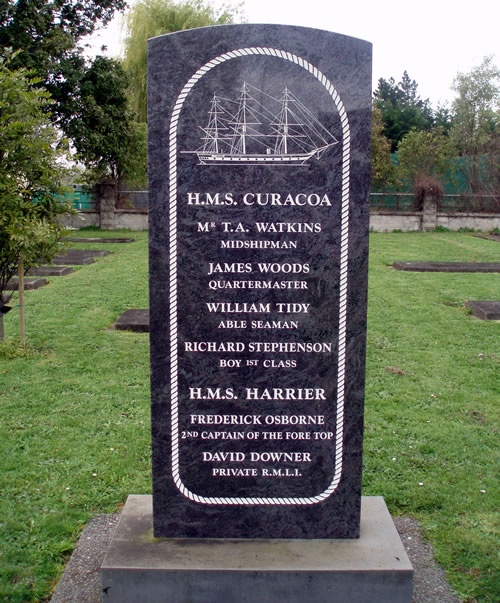
Rangiriri is a small town on State Highway 1, 17 km north of Huntly in Waikato. Here, on 20 November 1863, British troops and Waikato Māori sustained more casualties than in any other engagement during the New Zealand Wars. ‘Bloody Rangiriri’ was the decisive battle of the Waikato War. This memorial records the names of the officer and five seamen of the Royal Navy ships HMS Curaçoa and HMS Harrier who died in the assault.
On the afternoon of 20 November, Lieutenant-General Duncan Cameron attacked Rangiriri with some 1400 imperial troops. Their number included a naval brigade of about 100 officers and men from HMS Eclipse, Curaçoa and Miranda under the command of the Curaçoa’s Lieutenant Alexander.
The Rangiriri line was manned by about 500 defenders from tribes including Ngāti Mahuta, Ngātiteata, Ngāti Hine, Patupou, Ngāti Pāoa and Ngati Hauā. Despite success elsewhere along the line, the British failed in at least eight attempts to take the central redoubt before nightfall.
Historian James Cowan captures the sense of desperation in the naval brigade’s assault:
This [earlier] repulse only strengthened Cameron’s stubborn resolution to take the redoubt, and another assault was ordered. This time the Royal Navy men were selected for the forlorn hope. Captain Mayne, of H.M.S. “Eclipse,” was directed to make a frontal attack with ninety sailors of the Naval Brigade, consisting of portions of the crews of the “Eclipse,” “Curaçoa,” and “Miranda.” The bluejackets, with rifle and cutlass, dashed at the works and endeavoured to swarm up the straight-scarped parapet, but once more the stormers were thrown back, and dead and dying men strewed the ditch and the ground in front of it. A few reached the top of the parapet. Midshipman Watkins was one of them; he fell back into the trench with a bullet through his head. Commander Mayne was severely wounded in the left hip; Lieutenant Downes, of H.M.S. “Miranda,” was shot through the left shoulder; and two officers of the “Curaçoa” suffered bad wounds, Lieutenant Alexander in the right shoulder and Lieutenant C. F. Hotham (afterwards Admiral) in the right leg.
When this attack failed a party of seamen, under Commander Phillimore, of the “Curaçoa,” charged up to the ditch and threw hand-grenades over into the redoubt, but this attempt did not alter the position. In the Naval Brigade was Midshipman C. G. Foljambe (“Curaçoa”), afterwards Earl of Liverpool and father of a recent Governor of New Zealand. He and his comrades made several attempts to scale the parapet, but the task was hopeless.
The British suffered 130 casualties at Rangiriri. Of these, six officers and 41 men were killed in action or died later from their wounds. The officers, including Midshipman Thomas Watkins of HMS Curaçoa, were buried in Auckland’s Grafton Cemetery.
Many of the troops were buried at Rangiriri, probably according to regiment. It was later reported that ‘the dead were sewn up in blankets, and buried in rows only divided by a small space from the last resting-place of the enemy’s slain. Side by side they sleep in peace.’ The Māori church adjacent to the burial ground in Daniel Manders Beere’s 1864 photograph of the scene was built sometime before the battle.
Close examination of two of Beere’s photographs confirms that four of the five seamen killed in the assault on Rangiriri were buried together. James Woods and William Tidy of HMS Curaçoa, and Frederick Osborne and David Downer of HMS Harrier, were buried under the large white cross that is prominent in Beere’s photographs. It is not known exactly where in the cemetery the remains of the fifth seaman, Richard Stevenson (or Stephenson), were laid to rest.
This granite memorial is the second naval memorial to be erected at Rangiriri. In about 1999 it replaced an earlier monument, comprising a plain white marble obelisk on a series of plinths, which had been erected sometime before 1896.
The surviving portion of the original memorial obelisk is on display at the Rangiriri Heritage Centre and Café, across the road from the cemetery.
Additional images
See also: 1864 image showing the first navy memorial cross at Rangiriri
Inscription
Front face:
Erected / in memory of / the officer / and seamen of
/ the Royal Navy / who lost their / lives at the / storming of / Rangiriri on / 20
November 1863
Obverse face:
H.M.S. Curacoa / Mr T.A. Watkins / Midshipman /
James Woods / Quartermaster / William Tidy / Able Seaman / Richard Stephenson / Boy 1st
Class / H.M.S. Harrier / Frederick Osborne / 2nd Captain of the Fore Top / David Downer
/ Private R[oyal]. M[arines]. L[ight]. I[nfantry].
Further information
- Extract from ‘Local & General’, Otago Witness, 26 March 1896
- ‘The Battle of Rangiriri’, Evening Post, 6 June 1896
- James Belich, ‘Rangiriri’, in The New Zealand Wars and the Victorian interpretation of racial conflict, Penguin, Auckland, 1998, pp. 142–57
- James Cowan, ‘The Battle of Rangiriri’, in The New Zealand Wars: a history of the Maori campaigns and the pioneering period: volume I: 1845–1864, R.E. Owen, Wellington, 1955, pp. 326–35 (includes a plan of the Maori entrenchments and a cross-section of the central redoubt, pp. 328–9)
- Nigel Prickett, ‘The Waikato War, 1863–64’, in Landscapes of conflict: a field guide to the New Zealand Wars, Random House, Auckland, 2002, pp. 69–86
- Chris Pugsley, ‘Walking the Waikato Wars: Controversy at Rangiriri: 20 November 1863’, New Zealand Defence Quarterly, no. 15 (Summer 1996), pp. 31–7



Community contributions